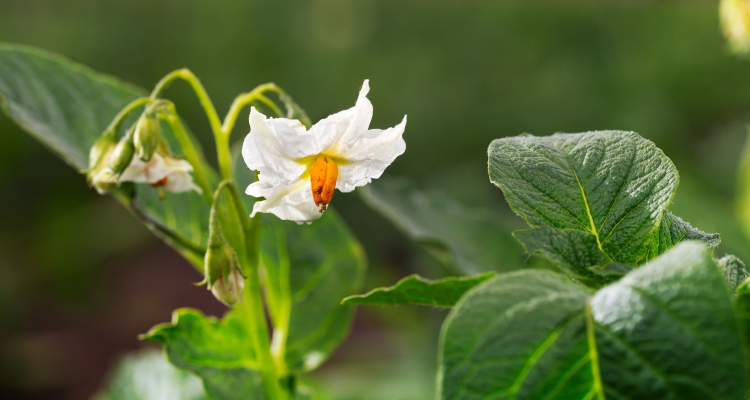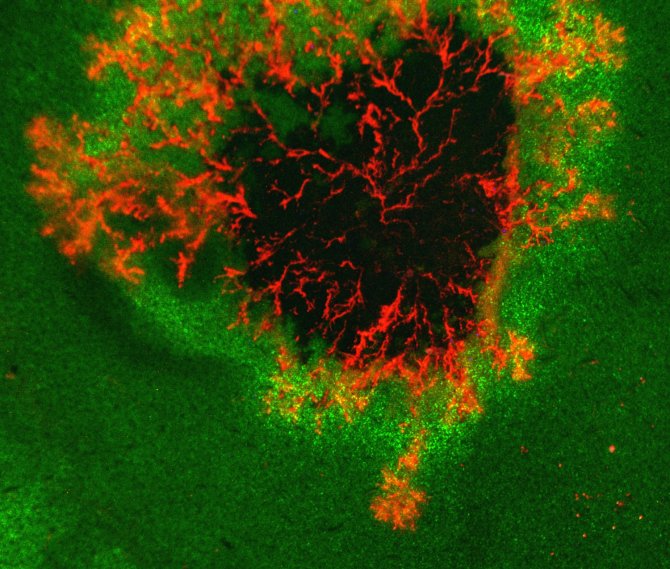Wageningen, The Netherlands
September 11, 2023

All over the world, huge quantities of crop protection agents are sprayed to control potato blight (Phytophthora infestans). The mechanisms of resistance of potatoes need to be better understood to make growing this crop more sustainable. Researchers of Wageningen University & Research together with their colleagues in Tübingen and Norwich have now taken an important step. Their research has been published in the renowned scientific journal Science.
“There is a continuous ‘arms race’ between the potato plant and Phytophthora,” says Vivianne Vleeshouwers, a plant scientist at WUR. The plant fiercely defends itself. An invasion of the “fungus” (actually an oomycete) immediately triggers a number of defence responses, such as making part of a leaf die off in a controlled manner to stop the advance of the disease. However, Phytophthora is able to repeatedly bypass these defences by means of mutating.
Recognising the disease
To defend itself the first thing the plant has to do is recognise the pathogen. “The plant has receptors for this, a kind of antennas. These bind tiny pieces of Phytophthora protein, which is the signal that something is wrong. This is when the defense responses kick in. So it is very important that the plant can actually detect the disease and has the right receptors in place to activate its defences", says Vleeshouwers.
These receptors are located either inside or on the outside of the cell. Receptors inside the cell are encoded by specific R genes (R stands for resistance), and potato breeders take advantage of these. They develop resistant varieties by selecting for these R genes. However, the problem is that the Phytophthora manages to break through that resistance, time and again.
“Much less is known about the receptors on the outside, on the cell surface, the PRR receptors. These receptors drive more general immune responses”, Vleeshouwers says. Plant breeders are currently focusing their attention on R genes, but more fundamental research is required to be able to benefit from less specific defense responses by the PRR.
To this end, WUR is cooperating with the University of Tübingen (Germany) and The Sainsbury Laboratory in Norwich (UK).

Late blight pathogen on a leaf. (Photo: Sebastian Schornack / The Sainsbury Laboratory)
PERU
Vleeshouwers: “We have been studying a specific type of PRR receptor called PERU. It binds a special piece of Phytophthora protein, Pep-13, which triggers the potato plant to recognise the disease. It was generally assumed that PRR receptors hardly change over time (a well-known example is the very stable receptor that recognises bacteria flagella). But we found that PERU actually does exhibit dynamic evolution, and changes much faster than the more well-known PRR receptors. This is a totally new insight.”
According to co-research leader Thorsten Nürnberger of the Centre for Plant Molecular Biology (ZMBP) at the University of Tübingen, the research results show that the evolution of immune receptors on the cell surface of plants (the PRR receptors) is much more complex than we previously thought. "There is not just one version of this receptor, but several variants that can recognise different binding molecules (the proteins of Phytophthora, ed.). This is a completely new finding."
Looking back in time
"Several wild potato species have variations of PERU. We have those plants in our collection and we can look back in time, as it were, to find out how they evolved”, says Vleeshouwers. “Once you understand their evolution, you can look for ways to translate that into applications. By selecting for the right receptors, you can increase the plant’s resistance to the disease.”
By looking back in time, the researchers were able to trace the origins of the plant’s evolution: the Andes. The receptor is called PERU, which stands for Pep-13 Receptor Unit. But of course, it also refers to the country of origin. Even better, the first author of the Science article, PhD student Yerisf Torres Ascurra, is herself from Peru.
Sustainable cultivation
This insight into this type of receptors (and more will undoubtedly follow) paves the way for the sustainable potato of the future. This plant will have specific resistance genes, as well as enhanced general defensive responses.
“Before today, breeders focused on R genes. However, the resistance they offer is constantly being thwarted. By studying how wild potato species survive in an environment where they are constantly assailed by diseases, we can discover what mechanisms they use, and then introduce these mechanisms in our own potato varieties", Vleeshouwers concludes.
Aardappels met de juiste antennes: oorsprong nieuwe resistentie tegen ziekte gevonden in wilde soorten
Bestrijding van de aardappelziekte Phytophthora infestans kost wereldwijd inzet van veel gewasbeschermingsmiddelen. Om te komen tot een duurzamere teelt, is meer inzicht nodig in de verdedigingsmechanismes van aardappelplanten. Wageningse onderzoekers hebben daarin samen met collega’s in Tübingen en Norwich een belangrijke stap gezet en haalden met hun onderzoek het gerenommeerde wetenschapsblad Science.
“Er is een voortdurende ‘wapenwedloop’ gaande tussen de aardappelplant en Phytophthora”, vertelt Vivianne Vleeshouwers, veredelingsonderzoeker bij Wageningen University & Research (WUR). De plant verdedigt zich met hand en tand: zodra de schimmel (eigenlijk een oömyceet) binnendringt, start de plant een aantal afweerreacties, bijvoorbeeld gecontroleerd een stukje blad laten afsterven om de opmars van de ziekte te stoppen. Phytophthora weet die afweer echter keer op keer te omzeilen door mutaties.
Herkenning van de ziekte
Stap één in de natuurlijke afweermechanismes tegen Phytophthora is dat de plant de ziekteverwekker moet herkennen. “Daarvoor heeft hij receptoren – een soort antennes. Die binden kleine stukjes eiwit van Phytophthora en dat is het signaal dat het mis is. Vervolgens komen de afweerreacties op gang. Dat vergt dus dat de plant inderdaad de ziekte ontdekt en de juiste antennes (receptoren) in huis heeft voor vervolg-acties”, vertelt Vleeshouwers.
Zulke receptoren zitten in de cel of aan de buitenkant van de cel. De receptoren in de cel worden gecodeerd door specifieke R-genen (R staat voor resistentie) en veredelaars maken daar gebruik van. Ze ontwikkelen resistente rassen door te selecteren op deze R-genen. Probleem is echter dat de schimmel die resistenties keer op keer weet te doorbreken.
“Over de receptoren aan de buitenkant op het celoppervlak – zogenaamde PRR-receptoren - is veel minder bekend. Ze sturen meer algemene afweerreacties aan”, vertelt Vleeshouwers. De belangstelling van de veredelaars concentreert zich nu vooral op de R-genen. Om op den duur gebruik te kunnen maken van de meer algemene afweerreacties, is fundamenteel onderzoek nodig. WUR heeft dat samen met de universiteit van Tübingen (Duitsland) en The Sainsbury Lab van Norwich (UK) opgepakt.
Peru
Vleeshouwers: “We hebben één soort PRR-receptor onderzocht met de naam PERU. Die bindt een speciaal stukje eiwit van Phytophthora, namelijk Pep-13, en dat zorgt ervoor dat de aardappelplant de ziekte herkent. Het algemene idee was dat PRR-receptoren in de loop van de tijd nauwelijks veranderen. Een bekend voorbeeld is de receptor die flagellen van bacteriën herkent, deze is zeer stabiel. Maar wij hebben ontdekt dat PERU juist wel een dynamische evolutie vertoont en veel sneller verandert dan andere meer bekende PRR-receptoren. Dit is een totaal nieuw inzicht.”
Volgens mede-onderzoeksleider Thorsten Nürnberger van het Centrum voor Plant Moleculaire Biologie (ZMBP) aan de Universiteit van Tübingen laten de onderzoeksresultaten zien dat de evolutie van immuunreceptoren op het celoppervlak van planten (de PRR-receptoren) veel complexer is dan we eerder dachten. “Er is niet slechts één versie van deze receptor, maar verschillende varianten die verschillende bindingsmoleculen (de eiwitten van Phytophthora, red.) kunnen herkennen. Dit is een compleet nieuwe bevinding."
Terugkijken in de tijd
Verschillende wilde aardappelsoorten hebben variaties van PERU. “Wij hebben die planten in onze collectie en kunnen zogezegd terugkijken in de tijd: achterhalen hoe de evolutie is verlopen”, vertelt Vleeshouwers. “En als je de evolutie begrijpt, kun je dat op den duur vertalen naar toepassingen. Dat wil dus zeggen: een grotere weerbaarheid tegen de ziekte door te selecteren op de juiste receptoren.”
Door terug te kijken in de tijd konden de onderzoekers de oorsprong van de evolutie achterhalen. Die ligt in de Andes. De receptor is getooid met de naam PERU. Het is een afkorting die staat voor: Pep-13 Receptor Unit. Maar hij verwijst natuurlijk ook naar het oorsprongsland. Bijzonder gegeven is verder dat de eerste auteur van het Science-artikel, promotiestudent Yerisf Torres Ascurra, zelf afkomstig is uit Peru.
Duurzame teelt
Dit inzicht in dit type receptoren, en er zullen er ongetwijfeld nog meer volgen, effent de weg voor de duurzame aardappel van de toekomst. Die is getooid met specifieke resistentie-genen, maar ook met een versterkte algemene afweer.
“Tot nu toe lag de nadruk bij de veredelaars steeds op de R-genen. Die resistentie wordt echter steeds doorbroken. Door te bestuderen hoe wilde aardappelsoorten zich staande houden in een omgeving met een voortdurende ziektedruk kunnen we achterhalen welke mechanismen ze gebruiken. En die vervolgens toepassen in onze aardappelrassen”, besluit Vleeshouwers.